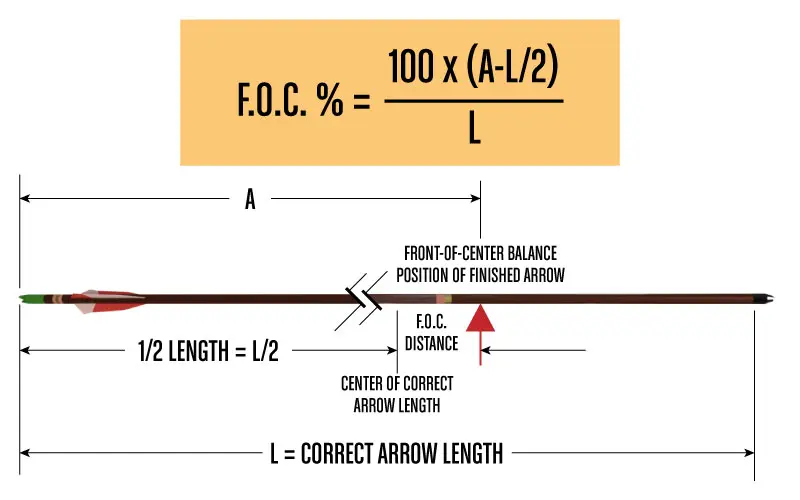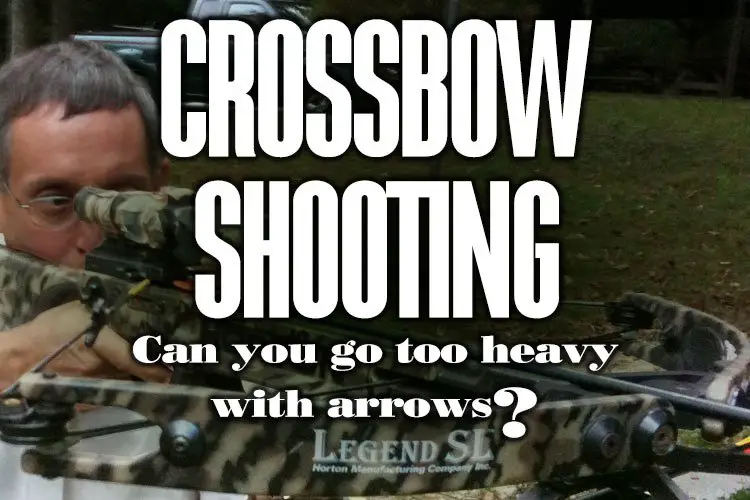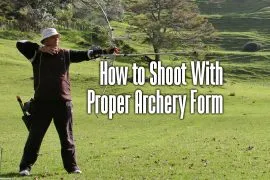[Updated 1 January 2024] Crossbows have been around for literal ages, and their popularity has risen and fallen through the years. The forerunner to the modern-day gun, these tools were once weapons of war and much bigger and heavier than they are today. They also had much heavier bolts designed to do more damage; today’s crossbows are still designed for power, but speed and distance are also essential components. With today’s more advanced crossbow shooting, can you go too heavy with arrows?
You can go to heavy with an arrow, but the answer is not as simple as that. To exaggerate to make a point, a one-pound arrow would plummet to the ground the minute it left your barrel. The heavier the arrow is, the faster gravity will pull it toward the ground, but arrows or bolts do not have an even weight throughout. Heavier bolts with more weight at the tip will have more energy and power behind them over short distances. The key is to find the right weight for you so you get the damage you need to be combined with the distance and accuracy you want.
What is FOC?
Table of Contents
The FOC stands for front of center, and it the total weight of the front half of your bolt. The more weight your bolt has in its FOC, the farther forward you will find its center of balance. The FOC is crucial because it determines the shape of your trajectory, aka the path that your arrow will follow to the target. Arrows with heavier FOCs will drop faster, giving the trajectory a sharper curvature. The FOC becomes more critical the further away the target is located as the arrow drop will increase over distance as the momentum decreases.
How Do I Find the FOC?
Now that you know the importance of the FOC, you will probably want to know how to calculate it. This will help rate the setup you are already using and give you information useful for building the best bolt for you. The following steps are needed to determine the FOC:
- Measure your bolt and divide its overall length by two.
- Balance the arrow on your finger until you find the perfect balance point and mark it with a marker.
- Measure the distance from the throat of the nock to your marker.
- Subtract the number from step one from the number in step three.
- Multiply your result by 100.
- Divide that number by the overall length of your bolt, and you get your FOC.
Heavier Vs. Lighter Arrow
The debate over a heavier or lighter arrow comes down to your personal preference. There is a give and take with the weight of your arrows, and, like all things in life, the more balanced it is, the better. A heavier bolt will do much more damage and have deeper penetration in the target, but it will not fly as far and lose accuracy over distance. A lighter arrow will fly much farther than a heavier arrow with greater accuracy but will not cause the same kind of damage. This is fine for target practice and smaller game hunting but will not do for larger game.
 When buying bolts, the speed rating on the package is based on a 400-grain bolt. A 500-grain bolt will be slower than what the box reads, and a 300-grain bolt will be significantly faster. If you wonder how much damage your bolt will do, you can use a kinetic energy calculator like this one. This will help you know how much punch is behind your arrow, which is especially helpful when hunting bigger, more dangerous animals like bears.
When buying bolts, the speed rating on the package is based on a 400-grain bolt. A 500-grain bolt will be slower than what the box reads, and a 300-grain bolt will be significantly faster. If you wonder how much damage your bolt will do, you can use a kinetic energy calculator like this one. This will help you know how much punch is behind your arrow, which is especially helpful when hunting bigger, more dangerous animals like bears.
These numbers may seem large with a wide margin, but the grain is so light that you wouldn’t be able to tell the difference if you held two bolts in your hand. To put it into perspective a single ounce equals 437.5 grains, so middle to high-end weight arrow only weighs an ounce.
Bolt Lengths
The length of your bolt will have multiple implications. Crossbow bolts measure between sixteen and twenty-two inches; you can get away with using a bolt that is longer than your crossbow recommends, but never shorter as your arrow tip can get stuck when firing. You can also potentially cause harm to your bow if you fire an arrow that is heavier than recommended.
The length of the bolt will affect its weight as well as its FOC. A longer bolt will have a FOC higher on the bolt than a shorter one. Shorter arrows are stiffer and don’t bend as much, which keeps them on a straighter path making them faster and giving them deeper penetration.
Other Issues That Aren’t Bolt Weight
Bolt weight is the most critical factor when it comes to the trajectory, accuracy, and penetration of your shot, but it is not the only factor. If you think you have the right weight and length for your bolt, but you are still experiencing issues, there are a few possible problems to check around your bolt.
Is the Bolt Structurally Sound?
If your arrow is not firing the way it is supposed to, the first thing you want to do is check for any cracks or dents in the shaft. Wood and carbon arrows can get cracks that will affect the flight pattern of the arrow, but more importantly, those shafts can splinter when firing, creating a potentially dangerous situation. Aluminum shafts are less likely to splinter, but they can dent or bend, which will affect your aim. Always dispose of a broken arrow as it is not worth the risk to keep using it.
Is the Bolt Straight?
A bolt can warp for several reasons, but no matter the reason, a warped bolt won’t fly straight. While there are machines that will test the straightness of the bolt for you, you can easily do it yourself. Remove the head and roll the arrow on a flat surface; this will usually point out any place where the shaft may not be straight. A bent shaft is not dangerous like a cracked one, but it will mess with your accuracy significantly.
Check Your Fletching
Fletching is the material, usually feathers or a faux stand in for feathers, and they are not just for decoration. Fletching is important for keeping your arrow flying straight, and while it is important, it is also somewhat fragile. The bad news is that fletching can quickly get tears or even fall off; the good news is that it is easily replaced without having to replace the whole arrow.
Prevention
The saying goes, an ounce of prevention is worth a pound of the cure, and that is true when it comes to keeping your bolts shooting straight.
- Inspect your bolts before you use them for damage.
- During target practice, try not to place your shots close together. If bolts hit each other, they will likely damage each other.
- Practice often, more practice means better shot placement, which means that there will be less of a chance of you hitting a hard spot on your target like a bone in an animal.
- Make sure to clean the bolts after use. If you have used them for hunting, there is likely a lot of gunk on them, and even the smallest piece of debris will affect the trajectory and the weight of your arrow.
Related Questions
How Heavy is a Broadhead?
The weight of a broadhead will affect the total weight of your bow and the FOC. Broadheads will range in size, shape, and length, but as a general rule, they will fall between 100 and 125 grains.
Can I Make My Own Bolts?
You can make your own bolts, and most experienced crossbow hunters prefer it. There are multiple steps involved, and for the best results, you will need a few special tools, but it is the best way to get the exact size and weight you like. If you plan to make your own bolts try out a few different manufacturers first to get a good idea of the weight and length of the bolt you want. Making your own bolts may take some trial and error, but materials are usually sold in bundles, so you’ll have plenty of supplies to work with.
Can You Go Too Heavy With a Crossbow?
A heavier crossbow will most likely have more power behind it and takes larger bolts. They are also usually more durable and last longer than lighter varieties. A heftier crossbow does have its advantages but going too heavy has more cons than pros. A heavier crossbow is harder to aim and will cause fatigue from repeated use or carrying it for long periods. It can even cause strain or injury to the neck, back, or shoulders if you’re not careful. For target practice, a heavy crossbow is probably fine, but it doesn’t make much sense for hunting, which makes using it for target practice pointless.









4 Comments
Pingback: What is the Best Bolt Weight and FPS? - Boss Targets
Pingback: Discover the Many Types of Bows - Boss Targets
Pingback: Types of Archery Competitions - Boss Targets
Pingback: Bear Cruzer Compound Bow - Boss Targets